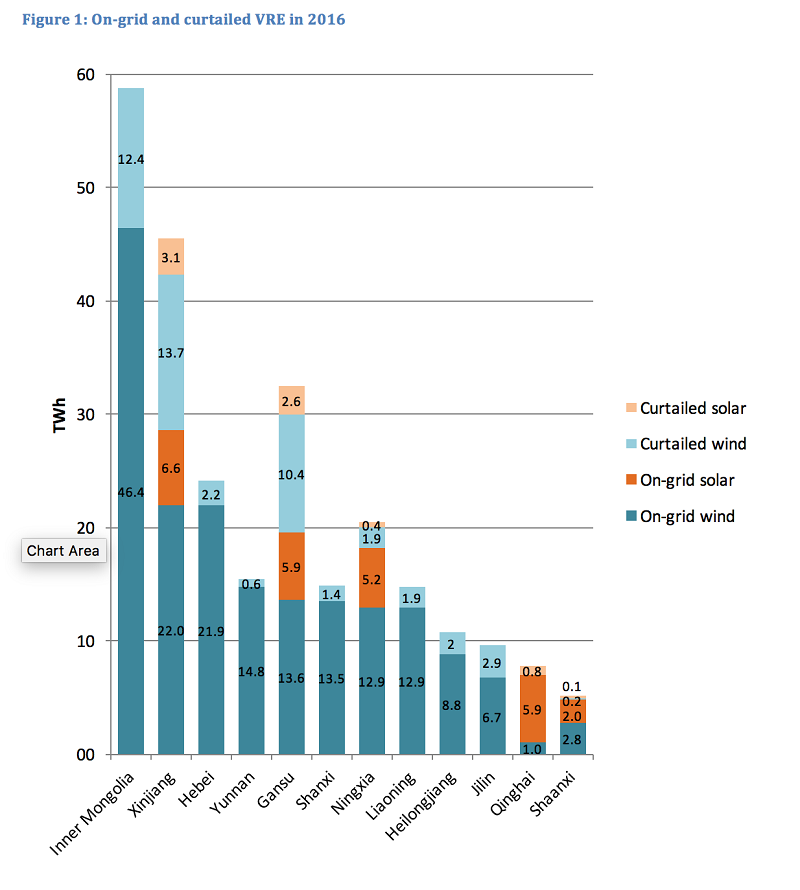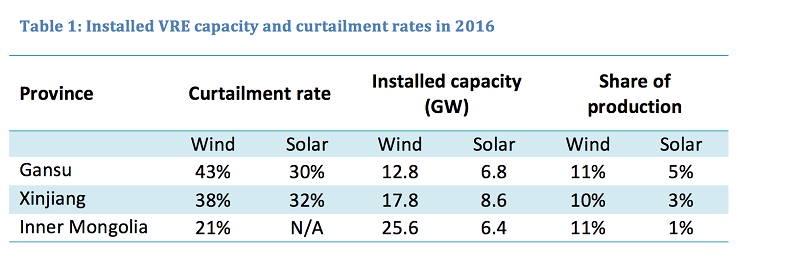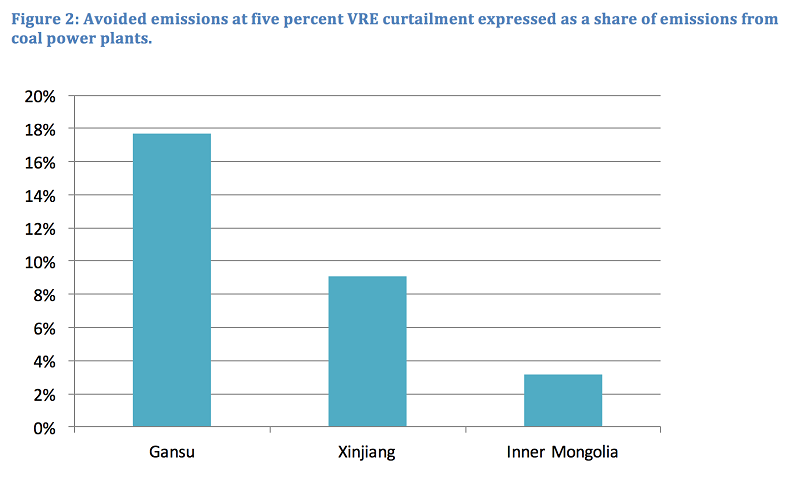When Premier Li recently delivered the 2017 government work report, he stressed the importance of efficient integration of renewable energy as a measure to make Chinese skies blue again. Although China has become the biggest investor in renewable energy and has the most installed capacity, it does not reap the full benefits of these investments. Record high curtailment of renewable energy prevents these resources from effectively contributing to clearer skies.
Record Curtailment Rates in 2016
According to the National Energy Agency (NEA), the national average wind curtailment rate in 2015 was 15 percent. Using the same calculation method, curtailment was 17 percent for 2016. Last year, the 11 provinces with three-quarters of the country’s installed wind power capacity, curtailed 49.7 TWh of wind power—enough to power Beijing for six months. The average photovoltaic (PV) curtailment rate in northwestern China in 2016 was 20 percent—a total of seven TWh of PV curtailed. Together, this represents 56.7 TWh of clean power not delivered to the grid.

[Note: All of these provinces have solar power, but PV production and curtailment data has only been available for provinces in the Northwest.]
The overall curtailment rates do not tell the whole story, as curtailment rates in several provinces were well above this average. Gansu and Xinjiang experienced the highest curtailment rates, respectively curtailing 40 and 37 percent of variable renewable energy (VRE). These provinces, together with Inner Mongolia, have the greatest installed VRE capacity and a large share of production.

The curtailment rates seen in China are very high relative to U.S. and European experience, where curtailment rates typically are between zero and five percent. International experience shows that some curtailment can be economically justified to enable high shares of VRE and ensure grid stability.
Reducing Curtailment Is a Priority
The Chinese government recognizes curtailment as one of the main challenges facing the transformation to a greener, more sustainable energy system. Document 9, published in 2015, sets the direction for reform of the power sector and highlights the need to improve dispatch and increase cross-provincial trading, which could reduce curtailment. A subsequent set of policies issued last year aims to further reduce curtailment by prioritizing renewable energy in dispatch and compensating generators for curtailment. These policies are yet to be rationalized, fleshed out, and implemented. When the NEA published the 13th five-year plan for the power sector in November last year, it stated intentions to keep curtailment within five percent, but did not provide details on specific short-term measures.
Developing New Renewables Also a Priority
The 13th five-year plan for wind power shows that China plans to continue rapid wind power development, with a goal of 210 GW installed by 2020. Furthermore, the plan hopes for drastically improved utilization of its installed capacity, as wind power is expected to deliver 420 TWh to the grid by 2020. The plan aims to target the curtailment challenges in the “three Norths,” while most capacity development will be in the southern and central provinces, which will respectively almost double and more than triple their onshore wind power capacity in the next four years. These provinces currently see low or no curtailment; however, several of them experience a serious lag in connecting turbines to the grid.
Solar power has also seen rapid development in recent years, reaching a total capacity of 42 GW in 2015. The plan is to continue expanding solar power capacity with an annual growth rate of over 20 percent to reach 110 GW, delivering 150 TWh to the grid in 2020. The five provinces in northwestern China had 45 percent of installed capacity in 2016; however, new capacity development will be focused in the east, thereby siting more generating capacity closer to areas with high demand.
While these renewable energy development goals are laudable, simply installing capacity is not enough to reduce harmful emissions. Excessive curtailment practices lead to unnecessary reliance on higher-emitting resources.
High Curtailment Rates Produce Unnecessary Pollution
Air pollution is a serious problem in every Chinese province, including the ones with high curtailment. In 2015, no province met the World Health Organization’s air pollution guidelines for PM2.5 concentrations and most did not meet the (less stringent) national guidelines. Ensuring the full utilization of the renewable energy already installed in China will yield significant air quality benefits. Making a rough assumption that the curtailment of renewable energy in Gansu, Xinjiang, and Inner Mongolia—the three provinces curtailing most VRE (Table 1)—was displaced by coal-fired power plants, it meant unnecessarily extracting, transporting, and burning 13.2 million tons of coal in 2016. Reducing curtailment could have avoided this and the associated tons of pollutants. Even if this is only a small part of total emitted pollutants, it means saving hundreds of lives every year using technology that is already installed (calculation based on research by the Health Effects Institute). Table 2 shows the tons of primary pollutants from coal-fired power plants that could have been avoided if VRE curtailment were five percent. Emissions reductions are estimated by applying provincial power production to region-specific emission factors. The emissions factors include the extensive efforts made during the 10th and 11th five-year-plan periods to reduce particulate and SO2 emissions from power plants, but not the control measures for NOX introduced in the 12th five-year plan.

Getting to a five percent curtailment rate in Gansu would mean saving emissions corresponding to 18 percent of the emissions from coal power plants in the province in 2016, for Xinjiang it would be nine percent, and Inner Mongolia three percent. The avoided NOX emissions combined correspond to taking about 50 million cars off the streets.

Conclusion
Renewables will play a more prominent role in Chinese energy production, making the ability to integrate this production into the grid increasingly important. In just a few years, China plans to double its share of wind power to six percent of total generation capacity. Wind and solar combined will make up eight percent of total generation capacity in 2020. However, the impact renewable energy will have on air quality depends on policymakers’ concrete plans and implementation actions to reach the 2020 target of five percent curtailment. China has made progress on improving its air quality, with pollutant concentrations in cities on a downward trend. At the current rate of improvement, it will take 23 years for Lanzhou, the capital of Gansu, 30 years for Urumqi, the capital of Xinjiang, and 12 years for the Inner Mongolian capital Hohhot to meet the World Health Organization’s PM2.5 standards. Reducing renewable energy curtailment can help accelerate progress. Making sure that VRE is efficiently integrated into the grid is a crucial step if China is to realize its air pollution targets and make Chinese skies blue again.
A different version of this blog is available on chinadialogue.
